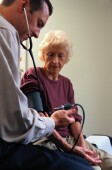
TUESDAY, Sept. 25 (HealthDay News) — The well-noted aging of the American population will continue long after the Baby Boomer generation crests, posing continuing economic challenges for the country for decades to come, a new congressionally mandated report states.
Not least of all, a consistently older population over the age of 65 will put a severe strain on federal programs such as Medicare and Social Security.
But the United States does have options that don’t guarantee a grim future, according to the report by the National Research Council.
These options, however, will require considerable changes in American lifestyles and in how federal programs are structured, the report, Aging and the Macroeconomy: Long-Term Implications of an Older Population, stated.
“We strongly believe that our nation needs to act sooner rather than later. The problem is not going to go away and it only gets tougher the longer we delay. The longer we wait, the larger the adjustments we will need to make,” Ronald Lee, a professor of demography and economics at the University of California, Berkeley, and one of the co-chairs of the committee that drafted the report, said at a Tuesday news conference.
Added co-chair Roger Ferguson, CEO of the Teachers Insurance and Annuity Association-College Retirement Equities Fund: “The population aging is, in fact, a good news story because people are healthier and living longer lives… However, there are a number of economic challenges. The most significant pressures are in social welfare programs designed to prevent poverty among the elderly.”
According to the report, the ratio of adults aged 65 and over compared with people aged 20 to 64 will increase by 80 percent in the coming decades. This is partly because the average life expectancy has risen from 47 years in 1900 to 78 years today, and is projected to be 84.5 years by the year 2050.
Another reason for the growing rates of older Americans: Declining birth rates as couples choose to have smaller families. This not only means a smaller proportion of the population will be under 65, it also means there will be fewer workers contributing taxes to support seniors, who are less productive and consume more, the report said.
While some people have saved amply for retirement, the report estimates that between one-fifth and two-thirds of today’s seniors haven’t saved enough, leaving them to rely heavily on Medicare and Social Security — programs that, along with Medicaid, now account for about 40 percent of all federal spending.
These public-health expenditures are likely to increase in coming years, the report stated.
Medicare, Medicaid and Social Security are on “unsustainable paths,” according to the report, posing significant economic risks.
“Together, the cost of the three programs currently amounts to roughly 40 percent of all federal spending and 10 percent of the nation’s gross domestic product,” the authors of the report stated in a news release. “Because of overall longer life expectancy and lower birth rates, these programs will have more beneficiaries with relatively fewer workers contributing to support them in the coming decades. Combined with soaring health care costs, population aging will drive up public health care expenditures and demand an ever-larger fraction of national resources.”
But the report outlines several strategies that could ease the burden on both younger and older adults as well as government in coming years.
One option would be to push the retirement age beyond the currently accepted age of 65 years. And given the example of other nations, this would be unlikely to steal jobs from younger people, as some fear.
Another strategy would be for workers to increase their savings while damping down their spending so they’d have more resources when they do retire. This would require an improvement in “financial literacy,” meaning teaching and helping people to make better financial decisions earlier in life.
A third potential avenue would involve consuming less while still paying taxes so the federal government could set aside more money for federal assistance programs to help support people as they age.
The National Research Council describes itself as an independent group whose mission is to “improve government decision making and public policy, increase public education and understanding, and promote the acquisition and dissemination of knowledge in matters involving science, engineering, technology, and health.”
The report was sponsored by the U.S. Department of Treasury with additional funding from the National Institute on Aging.
More information
To learn more about healthy aging visit the U.S. Centers for Disease Control and Prevention.

